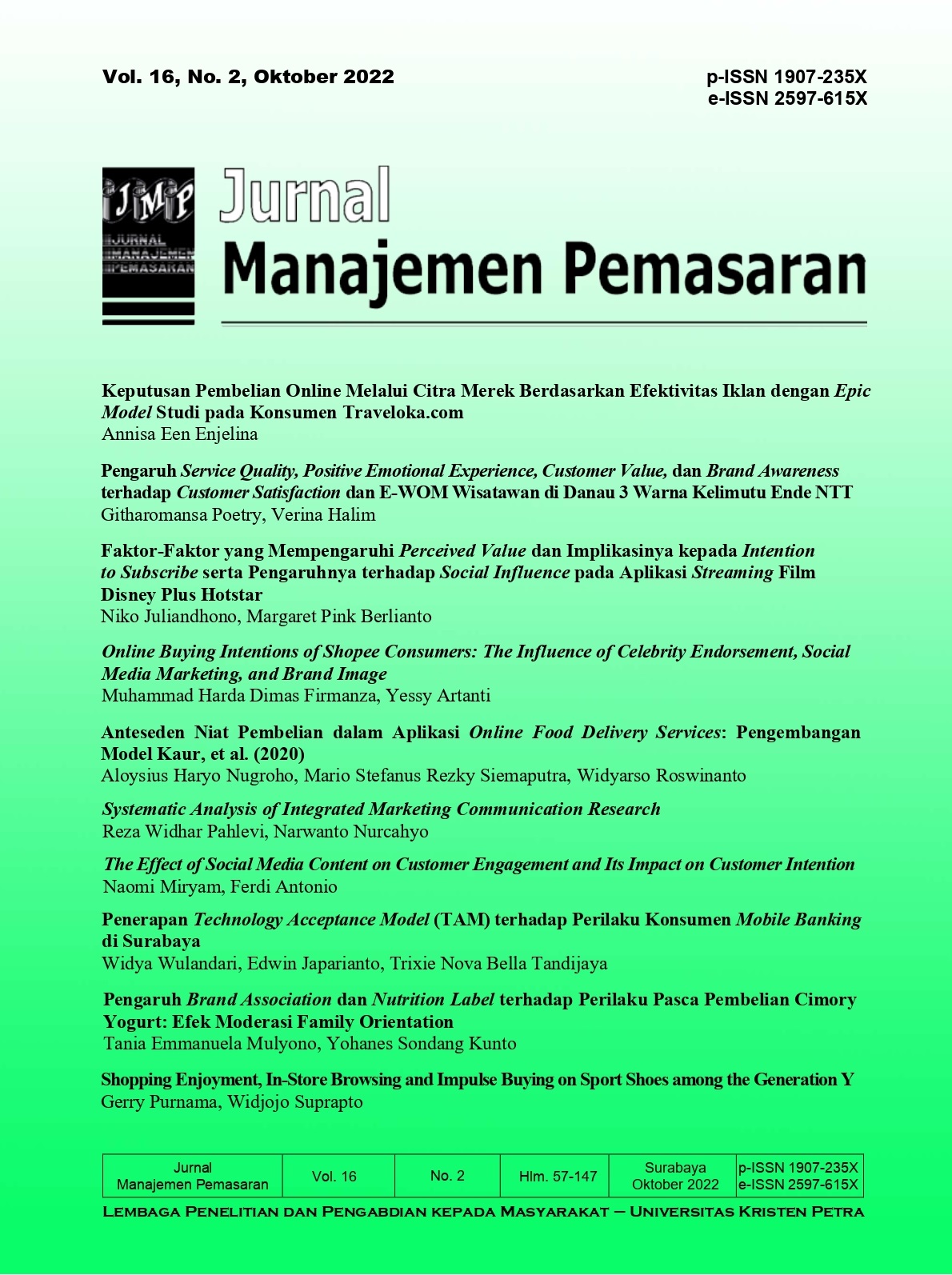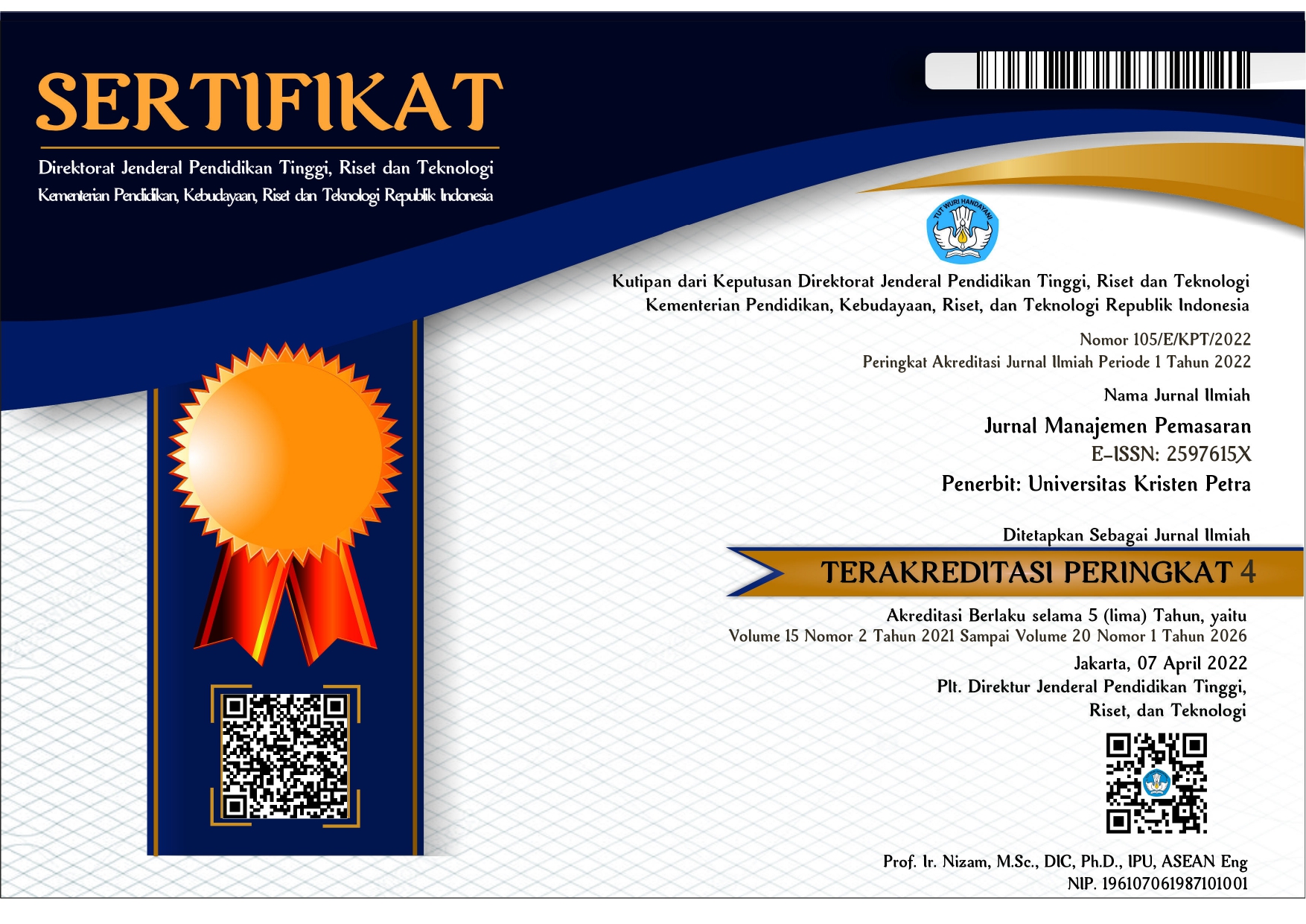THE EFFECT OF SOCIAL MEDIA CONTENT ON CUSTOMER ENGAGEMENT AND ITS IMPACT ON CUSTOMER INTENTION
DOI:
https://doi.org/10.9744/pemasaran.16.2.115-125Keywords:
Health content, social media, customer engagement, service usage intention, positive E-WOMAbstract
The rising number of fitness centers compelled business professionals to implement effective marketing techniques. This study aimed to analyze and test the antecedent of content in social media marketing, namely social interaction (SI), service provider interaction (SPI), self-concept (SC), functional information (FI), and entertaining information (EI) on customer engagement, and its effect on continuous usage intention (CUI) and positive electronic word of mouth (E-WOM), moderated by health literacy. The conceptual framework was empirically tested on customers of the fitness club. A quantitative survey employing the cross-sectional data method was done. The respondents were selected based on specific criteria, and data was collected using a Likert-scaled online questionnaire. The sample consisted of 236 respondents, and data analysis was conducted using Partial Least Square-Structural Equation Modelling (PLS-SEM). The results demonstrated that engagement has an effect on continuous usage intention (CUI) and the propensity to spread positive E-WOM (PEW). In addition, Health Literacy has not demonstrated a substantial moderating influence. In exchange, health literacy is characterized as a predictor of moderation. The research outcome may have managerial consequences for the fitness facility administration discussed in this article.
References
Aaker, D.A. (1991). Managing Brand Equity: Capitalizing on the Value of Brand Name. New York: The Free Press.
Abdullah, & Siraj, S. (2016). Brand Equity through Customer Engagement in Social Media: A Critical Review. IOSR Journal of Business and Management, 18, 38-46. https://doi.org/10.9790/487X-1808023846.
Bopp, T., Vadeboncoeur, J.D., Stellefson, M., & Weinsz, M. (2019). Moving Beyond the Gym: A Content Analysis of YouTube as an Information Resource for Physical Literacy. International Journal of Environmental Research and Public Health, 16(18), 3335. https://doi.org/10.3390/ijerph16183335
Brodie, R.J., Hollebeek, L., Juric, B., & Ilic, A. (2011). Customer Engagement: Conceptual Domain, Fundamental Propositions, and Implications for Research. Journal of Service Research, 17, 1-20. https://doi.org/10.1177/1094670511411703.
Chen, X., Shen, X., Huang, X., & Li, Y. (2021). Research on Social Media Content Marketing: An Empirical Analysis Based on China’s 10 Metropolis for Korean Brands. SAGE Open. https://doi.org/10.1177/21582440211052951.
Cochran, W. G. (1997). Sampling Techniques. New Jersey: John Wiley & Sons, Inc.
Cohen, S. (2004). Social Relationships and Health. American Psychologist, November, 676–684. https://dx.doi.org/10.1037/0003-066X.59.8.676.
Durau, J., Diehl, S., & Terlutter, R. (2022). Motivate Me to Exercise with You: The Effects of Social Media Fitness Influencers on Users Intentions to Engage in Physical Activity and the Role of User Gender. Digital Health. https://doi.org/10.1177/20552076221102769
Gómez, M., López, C., & Molina, A. (2019). An Integrated Model of Social Media Brand Engagement. Computers in Human Behaviour, 96, 196-206. https://doi.org/10.1016/J.CHB.2019.01.026.
Gao, Y., Wang, J., & Liu, C. (2021). Social Media’s Effect on Fitness Behavior Intention: Perceived Value as A Mediator. Social Behavior and Personality: An International Journal, 49(6), e10300. https://doi.org/10.2224/sbp.10300.
Gibney, S., & Doyle, G. (2017). Self-Rated Health Literacy is Associated with Exercise Frequency among Adults Aged 50+ in Ireland. European Journal of Public Health, 27(4), 755–761. https://doi.org/10.1093/eurpub/ckx028.
Hair, J. F., Hollingsworth, C. L., Randolph, A. B., & Chong, A. Y. L. (2017a). An Updated and Expanded Assessment of PLS-SEM in Information Systems Research. Industrial Management & Data Systems, 117(3), 442–458. https://doi.org/10.1108/IMDS-04-2016-0130.
Hair, J. F., Hult, G.T.M., Ringle, C.M., & Sarstedt, M. (2017b). A Primer on Partial Least Squares Structural Equation Modeling (PLS-SEM) (2nd ed.). Thousand Oaks: Sage.
Hair, J. F., Sarstedt, M., Ringle, C.M., & Gudergan, S.P. (2018). Advanced Issues in Partial Least Squares Structural Equation Modeling (PLS-SEM). Thousand Oaks: Sage.
Hult, G.T.M., Ringle, C.M., Sarstedt, M., & Thiele, K.O. (2017c). Mirror, Mirror on the Wall: A Comparative Evaluation of Composite-Based Structural Equation Modeling Methods. Journal of the Academy of Marketing Science. https://doi.org/10.1145/3505639.3505642.
Hair, J.F., Risher, J.J., & Sarstedt, M., & Ringle, C.M. (2018). When to Use and How to Report the Results of PLS-SEM. European Business Review, 31. https://doi.org/10.1108/EBR-11-2018-0203.
Keller, K.L. (1993). Conceptualizing, Measuring, and Managing Customer-Based Brand Equity. Journal of Marketing, 57(1), 1-22. https://doi.org/10.1177/002224299305700101.
Keller, K.L. (2013). Strategic Brand Management: Building, Measuring, and Managing Brand Equity (4th ed, Global Edition). Boston: Pearson.
Kock, N., & Hadaya, P. (2018). Minimum Sample Size Estimation in PLS‐SEM: The Inverse Square Root and Gamma ‐ Exponential Methods. Information Systems Journal, 28, 227-261. https://doi.org/10.1111/isj.12131.
Lee, J.H., Cheng, M., Syamsi, M.N., Lee, K.H., Aung, T.R., & Burns, R.C. (2022). Accelerating the Nature Deficit or Enhancing the Nature-Based Human Health during the Pandemic Era: An International Study in Cambodia, Indonesia, Japan, South Korea, and Myanmar, following the Start of the COVID-19 Pandemic. Forests, 13(1), 57.
León-Quismondo, J., García-Unanue, J., Burillo, P. (2020). Best Practices for Fitness Center Business Sustainability: A Qualitative Vision. Sustainability, 12, 5067. https://doi.org/10.3390/su12125067.
Liu, J., & Wang, J. (2021). Users' Intention to Continue Using Online Mental Health Communities: Empowerment Theory Perspective. International Journal of Environmental Research and Public Health, 18(18), 9427. https://doi.org/10.3390/ijerph18189427.
Mansur, S., & Ali, H. (2017). Impact of Customer Engagement to Reputation of the BRI Syariah Indonesia. International Journal of Economic Research. https://doi.org/10.31933/dijdbm.v3i2.1121.
Pansari, A., & Kumar, V. (2017). Customer Engagement: The Construct, Antecedents, and Consequences. Journal of the Academy of Marketing Science 45, 294–311. https://doi.org/10.1007/s11747-016-0485-6.
Prentice, C., Han, X.Y., Hua, L.-L., & Hu, L. (2019). The Influence of Identity-Driven Customer Engagement on Purchase Intention. Journal of Retailing and Consumer Services, 47, 339–347. https://doi.org/10.1177/21582440211052951.
Seo, Eun-Ju, & Park, Jin-Woo. (2018). A Study on the Effects of Social Media Marketing Activities on Brand Equity and Customer Response in the Airline Industry. Journal of Air Transport Management, 66. 36-41. 10.1016/j.jairtraman.2017.09.014.
Tourchian, A., Aali, S., Sanoubar, N., Zendeh, A.B. (2022). Exploring Customer Engagement Value from Relationship Benefits. International Journal of Islamic and Middle Eastern Finance and Management. https://doi.org/10.1108/IMEFM-12-2020-0603.
Yusuf, A.S., Hussin, A.R.C., & Busalim, A.H. (2018). Influence of E-WOM Engagement on Consumer Purchase Intention in Social Commerce. Journal of Services Marketing 32(4), 493-504. https://doi.org/10.1108/JSM-01-2017-0031.
Zaid, S., & Patwayati, P. (2021). Impact of Customer Experience and Customer Engagement on Satisfaction and Loyalty: A Case Study in Indonesia. The Journal of Asian Finance, Economics, and Business, 8(4), 983-992. https://doi.org/10.131106/JAFEB.2021. Vol8.No4.0983.
Zhang, Y., Zhang, J., & Liu, C. (2022). Motives for Employees Communicate Positive Electronic Word of Mouth (eWOM) on Social Network Sites: Exploring Moderating Mechanisms. Australasian Marketing Journal, 30(1), 60–73. https://doi.org/10.1177/1839334921999475.

















